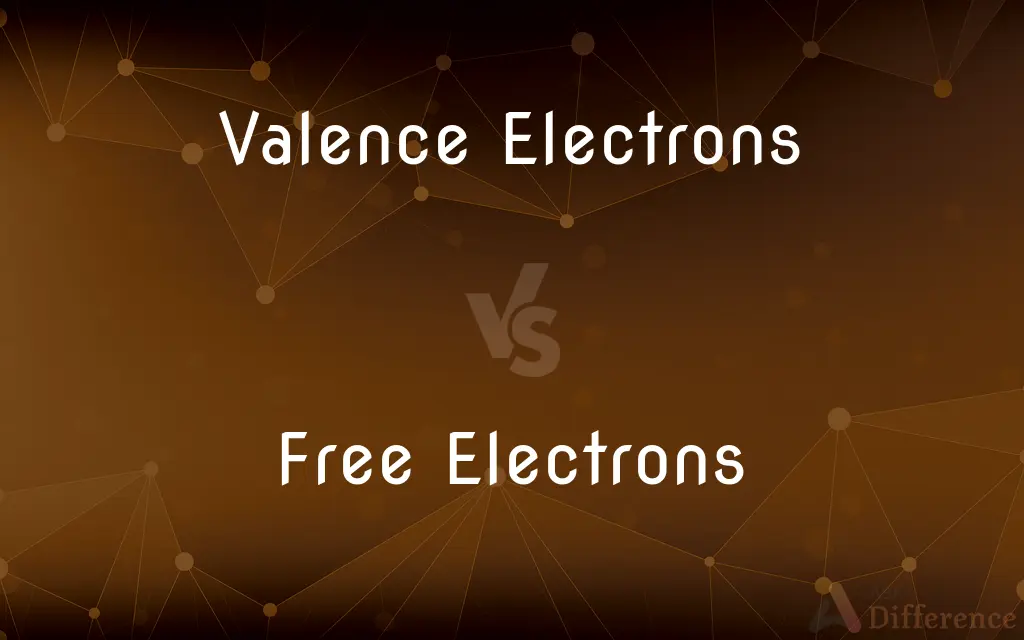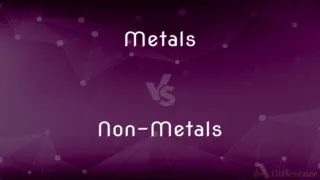Valence Electrons vs. Free Electrons — What's the Difference?
By Tayyaba Rehman — Published on November 12, 2023
Valence Electrons are outer shell electrons involved in bonding; Free Electrons are unbound electrons that move within a conductor.

Difference Between Valence Electrons and Free Electrons
Table of Contents
ADVERTISEMENT
Key Differences
Valence Electrons and Free Electrons serve unique and vital roles in the realm of chemistry and physics, thereby facilitating an understanding of material properties and chemical bonding. Valence Electrons reside in the outermost electron shell of an atom and are crucial in determining how an atom will bond with others. In contrast, Free Electrons are not bound to any particular atom and can move freely through the structure of a conductor, instrumental in electrical conduction.
In examining their roles, Valence Electrons are paramount in forming chemical bonds and thereby determining the chemical reactivity of an element. Free Electrons, however, drift through a conductor and are essential for the flow of electric current, not engaging directly in bonding processes, but critical in the electrical conductivity of materials.
In observing their movement, Valence Electrons generally remain in the outer shell of their respective atoms, moving to a different atom’s outer shell only during chemical reactions. Conversely, Free Electrons perpetually move throughout conductive materials, unconfined to any particular atom, thereby establishing an electric current when a voltage is applied.
Regarding their number, the amount of Valence Electrons in an atom is defined by its position in the periodic table, impacting its bonding properties with other atoms. Free Electrons, however, are not determined by the atom’s position in the periodic table but by external factors like energy input, which can release electrons from atomic orbitals.
The notion of Valence Electrons is pivotal in organic chemistry and in the study of materials and their properties, determining their reactivity and bonding patterns. On the other hand, Free Electrons form the essence of understanding electrical conduction in metals and semiconductors, offering insights into their electrical properties and behavior under different conditions.
ADVERTISEMENT
Comparison Chart
Location
In the outermost electron shell of an atom
Move freely through a conductor
Role
Vital for forming chemical bonds
Key to electrical conduction
Movement
Generally localized in an atom’s outer shell
Drift freely within conductive materials
Determination of Number
Defined by position in the periodic table
Influenced by external energy inputs
Influence on Properties
Impact chemical reactivity and bonding
Impact electrical and thermal conductivity
Compare with Definitions
Valence Electrons
Valence Electrons occupy an atom's outermost electron shell.
Carbon has 4 Valence Electrons enabling various bonding possibilities.
Free Electrons
Free Electrons facilitate the flow of electric current.
In conductors, electric current is generated by the movement of Free Electrons.
Valence Electrons
Valence Electrons participate directly in chemical bonding.
The sharing of Valence Electrons between atoms creates covalent bonds.
Free Electrons
Free Electrons are not bound to any specific atom.
Free Electrons move through metals, enabling electrical conduction.
Valence Electrons
Valence Electrons dictate an element's position in the periodic table.
Oxygen, with 6 Valence Electrons, is located in group 16.
Free Electrons
Free Electrons are crucial for electrical and thermal conductivity.
In metals, Free Electrons transfer both electrical charges and heat.
Valence Electrons
Valence Electrons can be shared, lost, or gained during reactions.
Chlorine gains a Valence Electron to achieve a stable electron configuration.
Free Electrons
Free Electrons can be generated through external energy inputs.
Photons can excite electrons, promoting them to Free Electron status.
Valence Electrons
Valence Electrons determine an element’s chemical reactivity.
Sodium readily reacts with water due to its single Valence Electron.
Free Electrons
Free Electrons originate from atoms but are not held in orbitals.
When voltage is applied, Free Electrons drift through a conductor, producing current.
Common Curiosities
What defines Free Electrons?
Free Electrons are unbound electrons that move freely in a conductive material.
How are Valence Electrons involved in bonding?
Valence Electrons can be shared, lost, or gained to form chemical bonds.
How do Free Electrons influence electrical conduction?
Free Electrons move through a conductor, enabling the flow of electric current.
What can cause electrons to become Free Electrons?
External energy, like heat or light, can elevate electrons to Free Electrons.
Can Valence Electrons conduct electricity?
Valence Electrons in metals can become free and contribute to electrical conduction.
Why do noble gases have limited chemical reactivity?
Their Valence Electrons are in a stable configuration, limiting reactivity.
Where do Free Electrons generally exist?
Predominantly in conductors and semiconductors, which allow electron movement.
What are Valence Electrons?
Valence Electrons are electrons in the outermost shell of an atom, involved in bonding.
Can Free Electrons engage in chemical bonding?
No, Free Electrons do not engage directly in chemical bonding.
How do Valence Electrons impact molecular shape?
Valence Electrons determine atom bonding, influencing molecular geometry.
What materials have a high concentration of Free Electrons?
Metals typically have a high concentration of Free Electrons.
What determines the number of Valence Electrons?
An element’s position in the periodic table determines its Valence Electrons.
How do atoms achieve a stable electron configuration through Valence Electrons?
Atoms gain, lose, or share Valence Electrons to achieve a full outer shell.
Can the number of Valence Electrons be altered?
Generally not without changing the atom's identity, but ions alter electron count.
Are Free Electrons present in insulators?
Typically, insulators have very few Free Electrons.
Share Your Discovery

Previous Comparison
Metals vs. Non-Metals
Next Comparison
Static VLAN vs. Dynamic VLANAuthor Spotlight
Written by
Tayyaba RehmanTayyaba Rehman is a distinguished writer, currently serving as a primary contributor to askdifference.com. As a researcher in semantics and etymology, Tayyaba's passion for the complexity of languages and their distinctions has found a perfect home on the platform. Tayyaba delves into the intricacies of language, distinguishing between commonly confused words and phrases, thereby providing clarity for readers worldwide.
















































